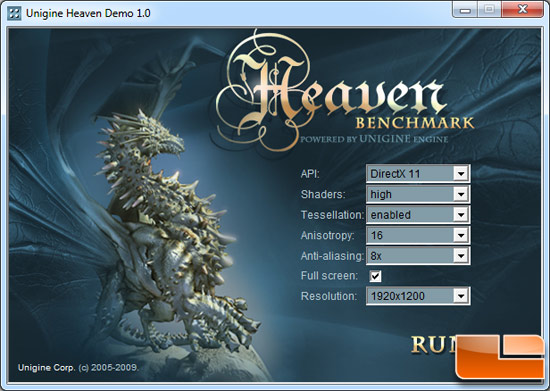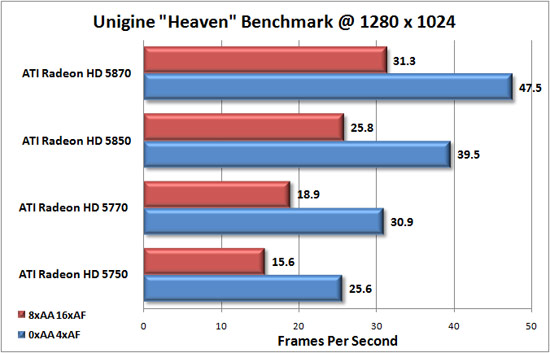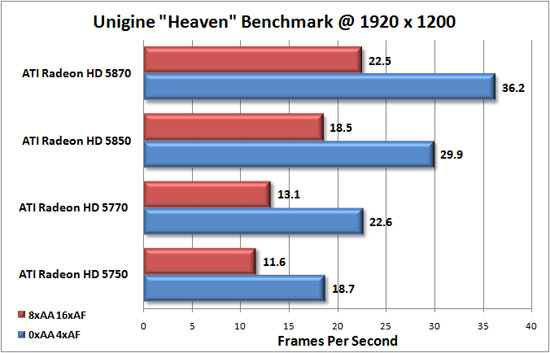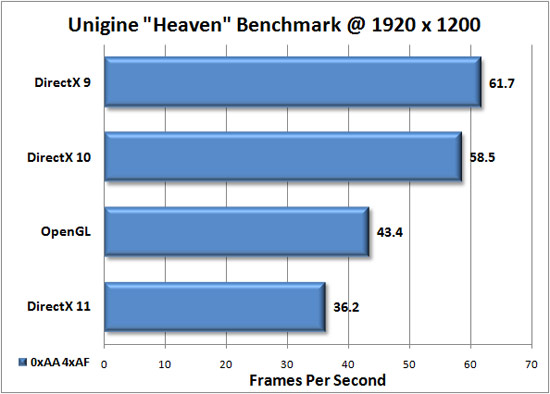Unigine ‘Heaven’ – The First DirectX 11 Benchmark
Benchmark Results

The ‘Heaven’ benchmark that uses the Unigine easily shows off the full potential of DirectX 11 graphics cards. It reveals the enchanting magic of floating islands with a tiny village hidden in the cloudy skies. With the interactive mode emerging experience of exploring the intricate world is within reach. Through its advanced renderer, Unigine is one of the first to set precedence in showcasing the art assets with tessellation, bringing compelling visual finesse, utilizing the technology to the full extend and exhibiting the possibilities of enriching 3D gaming. The distinguishing feature of the benchmark is a hardware tessellation that is a scalable technology aimed for automatic subdivision of polygons into smaller and finer pieces, so that developers can gain a more detailed look of their games almost free of charge in terms of performance. Thanks to this procedure, the elaboration of the rendered image finally approaches the boundary of veridical visual perception: the virtual reality transcends conjured by your hand.

For this benchmark VSync was turned off and we tested with 0x AA and 4x AF as well as 8x AA and 16x AF to see how increasing the antialiasing would impact system performance. We also ran the benchmark at 1920×1200 and 1280×1024 to see how the benchmark ran at some different common monitor resolutions.

At 1280×1024 the benchmark ran pretty smooth on all of the cards with antialiasing disabled. With 8x AA enabled only the Radeon HD 5870 seemed to run without stutters on this obviously tough benchmark.

With the resolution increased to 1920×1200 the Radeon HD 5750 never ran over 20 FPS, which means it was pretty much unplayable and had obvious stutters. The Radeon HD 5770 wasn’t much better as you can see from the chart above. Only the Radeon HD 5850 and 5870 without AA were able to run the benchmark fairly smooth. At a resolution of 1920×1200 with 8xAA and 16xAF enabled we found that the benchmark was more than enough to bring all of the Radeon HD 5000 series cards to their knees. It looks like the dual-gpu Radeon HD 5970 might be needed after all for those that want to crank up all the eye candy on 24″ and larger monitors.

The “Heaven” benchmark has native support of OpenGL, DirectX 9, DirectX 10 and DirectX 11. We couldn’t wrap up this article without taking a quick look at the differences between each API, so we fired up just the Radeon HD 5870 to take a peak at the performance levels. Our testing showed the biggest performance impact was actually when running DirectX 11 as you can see from the chart above. DirectX 9 was by far the quickest, but most of our readers would have guessed that! The benchmark uses OpenGL 3.2 and while there is an AMD_vertex_shader_tessellator OpenGL extension avaialble on AMD cards since HD 2xxx tesselation does not work in the demo. Unigine said that OpenGL tesselation is completely broken in current video drivers from AMD. Their developers are aware of the problem and have already fixed it in their internal builds, but it will take 2 months more before these fixed drivers will be available publicly.
Well, that completes our first quick look at DirectX 11 gaming performance across all of the Radeon HD 5000 series cards, so hopefully now you have a better sense of how each video card stacks up against one another!

Comments are closed.